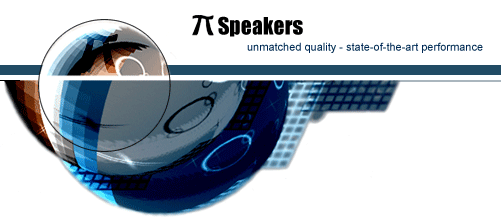π Subwoofer

There are several advantages to using subwoofers. First is the greater extension provided. Most woofers are hard pressed to get much below 40Hz but a subwoofer will reach an octave lower. Second is the reduction of bandwidth required of the woofer or midwoofer. This makes the higher frequencies coming from the woofer more clear. This is extremely important in the midrange. Third is the possibility of smoothing room modes using more than one subwoofer.
The multi-sub approach works by averaging out room modes using dense interference between sound sources. Low frequency sound travels very differently in a room than it does outdoors. Reflections from each wall, the floor and ceiling combine to form multiple virtual sources than cause interference with each subwoofer. These form nulls that are far enough apart to be noticeable. You can't get around the interference indoors so the only way to smooth the sound field is to increase the density of interference. Dense interference averages the sound field because the nodes and anti-nodes become so closely spaced they are indistinguishable. By using multiple subs, this can be accomplished, and the energy distribution is made smoother throughout the room.
Instead of high-passing the mains, allow them to overlap with the subs. This will smooth bass response up to the Schroeder frequency, which is usually between 100Hz to 200Hz in most home listening rooms. When stereo mains are used, a single sub then provides a third sound source below the Schroeder frequency and a pair of subs added to the mains provides four sound sources. There is a lot to be gained by using at least two subs, and three subs is better. Four is better too, but beyond that the improvements aren't significant.
Placement is important for this approach to work. Since it requires interference, the subs should not be placed within 1/4λ of the mains or each other. What is intended is for nulls formed by one sub and its boundary reflections to be filled in by other subs. Nodes from one subwoofer should align with anti-nodes from another. Since the position of each node changes with frequency, proper placement of each subwoofer is highly dependent on room layout, as is its crossover frequency. Sometimes it even makes sense to reverse phase on one or more subs; Remember again, it is interference that makes this work.
In general, subs placed near the mains can be driven to a higher frequency. They'll be more effective at smoothing the higher frequency range in the modal region. Subs placed further away smooth lower frequency modes but should be crossed lower too. Sometimes a balance can be struck with a pair of woofers placed just a few feet from the mains, other times it makes more sense to position subwoofers further than that. Start with at least two subs, add one or two more if needed for troublesome rooms.
π Speakers Open Forum
Where Builders, Buyers, Owners and Users meet online
Email for
a Quote or for More Information
Helpful Documents and Software
 π Speaker Whitepaper explains the concepts and evolution of modern waveguide and constant directivity loudspeakers π Speaker Whitepaper explains the concepts and evolution of modern waveguide and constant directivity loudspeakers
 π Speaker Crossover Document analysis of circuits used in waveguide and constant directivity loudspeakers π Speaker Crossover Document analysis of circuits used in waveguide and constant directivity loudspeakers
 "Crossover Electronics 101" Seminar Handout "Crossover Electronics 101" Seminar Handout
 JBL Professional Sound System Design Manual JBL Professional Sound System Design Manual
 Passive Crossover Spice models, complete with the AIM Spice modeling program Passive Crossover Spice models, complete with the AIM Spice modeling program
 Pialign Analysis Software to help you design your enclosures. This is the old Altair original from 1977. Pialign Analysis Software to help you design your enclosures. This is the old Altair original from 1977.
 Plot the response curve of your design with Carlson's BoxPlot program Plot the response curve of your design with Carlson's BoxPlot program
 Plot the response curve of horns with the HornResp program Plot the response curve of horns with the HornResp program
 Convert Metric and Imperial measurements with the Madison Measurement Converter Convert Metric and Imperial measurements with the Madison Measurement Converter
[ Technologies ] [ Products ] [ Specs & Prices ] [ Shopping Cart ] [ Forum ] [ Contact Us ] [ Home ]
|







